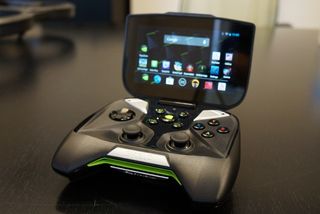Final Nvidia Shield Build Has High-End Graphics, Drone Control

Nvidia is gearing up to begin shipping its Shield handheld gaming console later this month, and we had the chance to go hands-on to see exactly what gamers will be getting for that $349 price tag. Shield has come a long way since its initial unveiling at this year’s CES, with a refreshed design that adds a more natural feel to the controller by improving the button quality on the directional pad and depressing the joysticks among other minor tweaks.
We saw Nvidia’s new Shield design at this year’s CTIA in Las Vegas, but this time we got a more in-depth look at the specific development tools that make Tegra 4 graphics stand out from the rest. When playing the Tegra-optimized Dead Trigger 2, for example, the nuances of our environment truly came to life.
Tegra 4 Graphics and the Mobile Experience
When perusing your surroundings in Dead Trigger 2, you’ll notice vivid reflections and refraction in puddles of water, realistic color textures and lens flare when looking at the sky, and natural body movements from your opponents as you gun them down. This is because the Tegra 4 chip incorporates PostFX, Dynamic Lighting, and Soft Body Simulation to depict an accurate and more lifelike atmosphere.
It’s hard to get the full effect through our video, but even by getting a secondhand look at the graphics quality on the TV screen you can notice the light reflecting off the water and the detailed ripples of smoke wafting through the air. Shield is the first product to hit the market that will ship with Nvidia’s Tegra 4 chip, and the Android-powered gaming device will come with a slew of Tegra-optimized titles from the Google Play store neatly organized into its Tegra Zone hub.
MORE: 10 Most Anticipated PC Games of 2013
But the Shield isn’t restricted to hardcore gaming titles, as you’ll be able to download any game available in the Google Play store. While Nvidia tells us the Shield isn’t meant to be a tablet replacement, you can load media-centric apps and most other applications from the Google Play store on to the device as well. It’s also worth noting that Shield runs the pure version of stock Android in addition to its own skinned version, and you can switch between both modes by pressing the glowing button in the center of the device.
Stay in the know with Laptop Mag
Get our in-depth reviews, helpful tips, great deals, and the biggest news stories delivered to your inbox.
The Shield’s front-mounted speakers come with built-in reverb chambers and an equalizer for tweaking sound quality. When blasting Daft Punk’s new album through Shield, sound came through boisterously with a full-bodied sound, although don’t expect the handheld to get quite as loud as your laptop or external speakers.
PC Streaming
One of the core ideas behind Shield is bridging the PC and mobile experience in one device, which is why players can stream Steam titles from their Nvidia GeForce GTX GPU-powered PCs directly to the handheld. Shield connects wirelessly to your PC via 802.11n, bringing PC-class graphics to the Shield’s 720p 5-inch touch screen display. During our demo of Metro Last Light, we didn’t see any noticeable latency between the PC or Shield, and the game streamed seamlessly. Nvidia tells us that this feature will be in beta when the device launches this month.
Third-Party Apps
While we’ve seen the Shield stream games, play demanding Android titles and run apps from the Google Play store, we’ve gotten a new sense of what the portable gaming system can do in the real world. Nvidia says APIs for the Shield have been released so that third-party developers can create apps specifically for the device, one example being the AR Free Flight app for the Parrot Drone.
Nick Stam, Nvidia’s director of technical marketing, controlled the drone and navigated it down a hallway by using the Shield-optimized app. The various Wi-Fi networks in our surrounding area interfered with the Parrot Drone, making it slightly difficult to control. However, after one crash landing Stam successfully steered the vehicle toward the other end of the office.
At $349, Shield will be the most expensive handheld video game console when it launches later this month, costing $100 more than the PS Vita and $180 more than the Ninendo 3DS. Is it worth the premium price tag? We won’t know until we bring you our full review, but the Shield is certainly a refreshing take on mobile and PC gaming.
